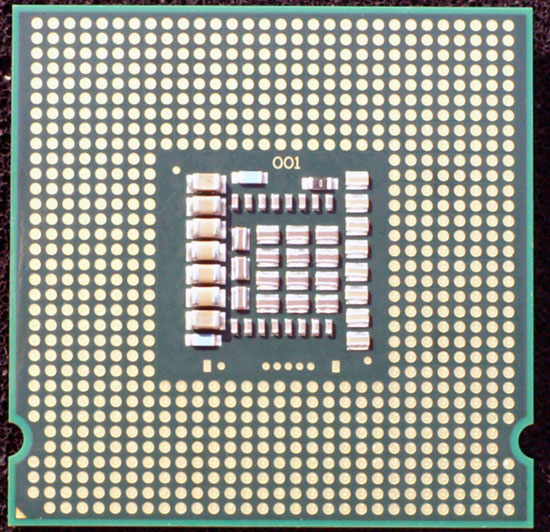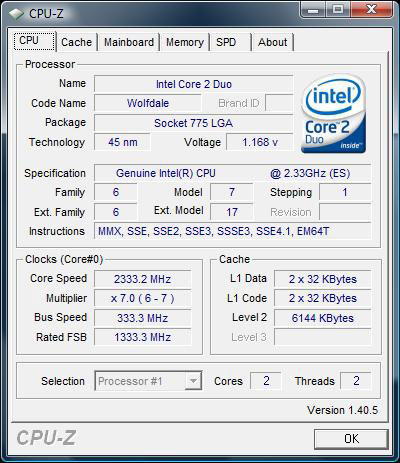The Penryn Preview - Part I: Wolfdale Performance
by Anand Lal Shimpi on August 21, 2007 12:35 PM EST- Posted in
- CPUs
Penryn's Launch Schedule
The launch will work like this: late this year (Q4), Intel will introduce a a new Extreme Edition processor based on Yorkfield (quad-core Penryn). Given that most Extreme Edition chips start out with a $999 price tag, that's where we'd expect the first quad-core Penryn to fall as well.
More affordable Penryn won't arrive until Q1 2008, which is great news for AMD. In the beginning of next year, Intel will introduce both mainstream Yorkfield and Wolfdale (dual-core Penryn) parts. We'd expect Wolfdale based chips to run at between 2.33GHz and 3.00GHz, while Yorkfield will probably top out at 3.33GHz.
In Q2 2008, Intel will push Penryn even further down the line and introduce a Wolfdale based E4xxx successor. This version of Wolfdale will have a 1066MHz FSB and drops support for Intel Virtualization Technology and TXT.
The Chip
Intel is keeping its few remaining cards close at hand, and thus it is only sampling lowly 2.33GHz Wolfdale/Yorkfield chips. It's not an issue of getting the 45nm process to clock high enough (as you'll see from our overclocking tests), so we'd guess that Intel doesn't want to have the performance of its top of the line 3.33GHz Yorkfield leaked until after Phenom hits.

Wolfdale's underside - we have to hide the other side so Intel doesn't murder our mole in its sleep

Conroe's belly for comparison
The 2.33GHz Wolfdale we're looking at today is best compared to the Core 2 Duo E6550 (2.33GHz Conroe), and that's exactly what we're doing.

Our Wolfdale is also not the final stepping that will be shipping next year; we've got A0 silicon and A1 should be ready in the coming weeks. Despite the not-final state of the silicon, we had absolutely no problems with the chip in our test bed. We tossed it in our Gigabyte GA-P35C-DS3R test bed and ran through a subset of our test suite without so much as a BIOS update. We are waiting on the first Penryn-tuned motherboards and BIOSes to arrive, so performance may increase from where we're at today.
The Test
| CPU: | Intel Core 2 Duo E6550 (2.33GHz/1333MHz) Intel Wolfdale 2.33GHz/1333MHz |
| Motherboard: | Gigabyte GA-P35C-DS3R (Intel P35) |
| Chipset: | Intel P35 |
| Chipset Drivers: | Intel 8.1.1.1010 (Intel) |
| Hard Disk: | Seagate 7200.9 300GB SATA |
| Memory: | Corsair XMS2 DDR2-800 4-4-4-12 (1GB x 2) |
| Video Card: | NVIDIA GeForce 8800 GTX |
| Video Drivers: | NVIDIA ForceWare 158.18 |
| Desktop Resolution: | 1600 x 1200 |
| OS: | Windows Vista Ultimate 32-bit |










55 Comments
View All Comments
OddTSi - Tuesday, August 21, 2007 - link
Exactly. As I was scrolling down that overclocking page I actually expected them to show what they did (how high it goes without a voltage bump) and then to cap it off at the very bottom with a "oh, here's the absolute highest we could get it to" screen shot.Go back in the lab Anand, stick the biggest HSF you've got on there and crank it up until it can't go up anymore and tell us what you got it to. ;)
gigahertz20 - Tuesday, August 21, 2007 - link
Anand has been slacking, first in the Q6600 GO article he forgets to mention what HSF he used and now he forgets or didn't want to raise the stock core voltage to see what the maximum overclock is? Bahhhhhh, I nominate all articles to either be written by Wesley Fink, Gark Key, Jarred Walton, or Derek Wilson.NullSubroutine - Tuesday, August 21, 2007 - link
I would like to see such benchmarks as well, if you have the time constraints to do so.It would be interesting to compare 3.33 C vs 3.33 P to see what kind of scaling difference there is between the two. And just overall max clock with volt increase you could get with revision A0 (with benchmarks) it would be a good performance preview for a ways down the road.
retrospooty - Tuesday, August 21, 2007 - link
"It would be interesting to compare 3.33 C vs 3.33 P to see what kind of scaling difference there is between the two. And just overall max clock with volt increase you could get with revision A0 (with benchmarks) it would be a good performance preview for a ways down the road"I second that. Hopefully the next review has what we all came to see = )
Seriously though. since the cache has improvements, and is also larger, we may well see it scale better. In other words its an avg of 5% faster at a meager 2.33 ghz, but what about 3.5, or higher which I am sure could be achieved by raising voltage. It may be quite a bit more.
Hippiekiller - Tuesday, August 21, 2007 - link
Im almost glad (almost) to see that the performance difference isnt that great. It would be interesting to see each company have similar performing parts.My question is would similar performance lead to an even more aggressive price war then the one we have seen recently? Or, would each company just stop at a relatively higher price then we currently see, not willing to slash unless it has to in order to counter the others move.
Spoelie - Tuesday, August 21, 2007 - link
You're not taking into consideration the higher clock speeds penryn will undoubtly have, which moves the performance delta up a bit more than the 5% at the, most likely, equal pricepoints of conroe chips.FujiT - Tuesday, August 21, 2007 - link
ok, Penryn is a die shrink with some tweaks. The average boost is 5% and that's not including the boost from SSE4 which pretty much results in a 100% boost in performance.And the retail Penryns will probably overclock better. The initial stepping supposedly had some problems reaching the high clock speeds that Intel promised, but it's been said that the new stepping solved that problem.
With Penryn, the performance boost not only comes out from the IPC increase, but the performance in clock speed. It's supposed to top out at 4 GHz (according to Intel) and Nehalem is supposed to pick up where Penryn left off clock speed wise.
duploxxx - Wednesday, August 22, 2007 - link
the IPC performance increase is minimal, when a program likes more cache it is faster, if not it is the same. these benches from anand show it.we'll see how far it will go with penryn and GHZ, in Q1 2007 they were not sure if they were able to fit the 3,33GHZ into a 120W TDP !!!!
About you're future... if it said by intel then leave it here out of the comments to ne you are just a fanboy, Nehalem is still vaporware and you guys are already hyping it... memorycontroller and fast huge on die caches do not work together....!!!!!
@anand, what was the stepping of you're conroe versus wolfdale.
fitten - Thursday, August 23, 2007 - link
Why do you say that?
GhandiInstinct - Tuesday, August 21, 2007 - link
I love having an answer to the #1 question in my head for months.
Thank you AnandTech!